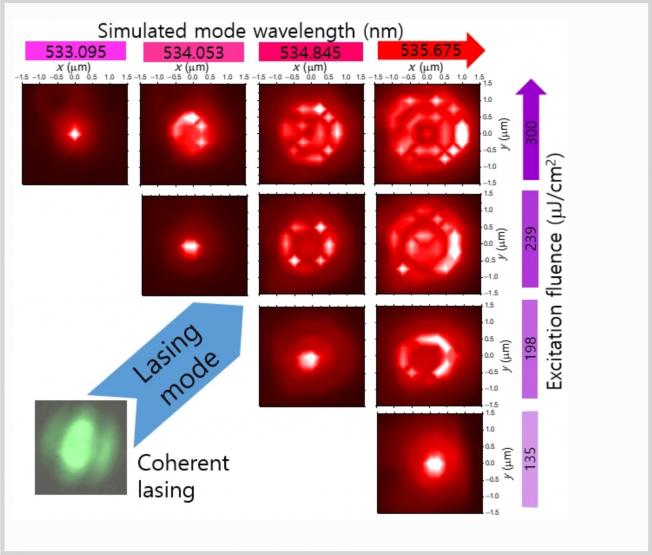Coarse and fine-tuning of lasing transverse electromagnetic modes in coupled all-inorganic perovskite quantum dots
Nano Research Springer Science and Business Media LLC (2020)
Abstract:
<jats:title>Abstract</jats:title> <jats:p>Inorganic perovskite lasers are of particular interest, with much recent work focusing on Fabry-Pérot cavity-forming nanowires. We demonstrate the direct observation of lasing from transverse electromagnetic (TEM) modes with a long coherence time ∼ 9.5 ps in coupled CsPbBr<jats:sub>3</jats:sub> quantum dots, which dispense with an external cavity resonator and show how the wavelength of the modes can be controlled via two independent tuning-mechanisms. Controlling the pump power allowed us to fine-tune the TEM mode structure to the emission wavelength, thus providing a degree of control over the properties of the lasing signal. The temperature-tuning provided an additional degree of control over the wavelength of the lasing peak, importantly, maintained a constant full width at half maximum (FWHM) over the entire tuning range without mode-hopping.</jats:p>Coarse and fine-tuning of lasing transverse electromagnetic modes in coupled all-inorganic perovskite quantum dots
Nano Research Springer Science and Business Media LLC 14:1 (2020) 108-113
Abstract:
<jats:title>Abstract</jats:title> <jats:p>Inorganic perovskite lasers are of particular interest, with much recent work focusing on Fabry-Pérot cavity-forming nanowires. We demonstrate the direct observation of lasing from transverse electromagnetic (TEM) modes with a long coherence time ∼ 9.5 ps in coupled CsPbBr<jats:sub>3</jats:sub> quantum dots, which dispense with an external cavity resonator and show how the wavelength of the modes can be controlled via two independent tuning-mechanisms. Controlling the pump power allowed us to fine-tune the TEM mode structure to the emission wavelength, thus providing a degree of control over the properties of the lasing signal. The temperature-tuning provided an additional degree of control over the wavelength of the lasing peak, importantly, maintained a constant full width at half maximum (FWHM) over the entire tuning range without mode-hopping.</jats:p>2D photocatalysts with tuneable supports for enhanced photocatalytic water splitting
Materials Today Elsevier 41 (2020) 34-43
Abstract:
Sustainable hydrogen production is attracting increasing attention and visible-light-driven water splitting is considered as one of the most promising approaches for hydrogen evolution and solar energy storage. Different materials have been screened at mild conditions in recent decades and 2-dimensional (2D) layered materials are considered good candidates for the photocatalytic water splitting reaction. 2D single layer MoS2 has shown its potential in various catalytic systems, and has also been used in photocatalytic water splitting reaction recently. However, current studies of MoS2 monolayers give low intrinsic activity, preventing it from practical applications. This is attributed to the rapid recombination of the photo-excited charge carriers at room temperature, resulting in poor quantum efficiency (QE). Herein, a state-of-the-art strategy to prolong the exciton lifetimes is reported, which is achieved by combining the 2D MoS2 nanosheets with solid state polar-faceted supports. The charge separation process can be facilitated by the strong local polarisation introduced by the polar-faceted supports, and tuned by changing the supports with different surface polarities. Polar oxide surface is the exposure of oxygen-terminated high energetic facet, which is known to give a net dipole moment perpendicular to its surface. Such variation in the surface properties of the support to the above metal would lead to a difference in metal-support interaction(s). The resulting composite structures show great enhancement toward the visible-light-driven photocatalytic water splitting reaction, giving hydrogen and oxygen evolution in a stoichiometric 2:1 ratio at elevated temperatures from pure water. Photocatalytic performances are improved by the prolonged exciton lifetimes and exceptional hydrogen evolution activity of 2977 μmol g−1 h−1 with impressive QEs are obtained over Ru-doped MoS2 nanosheets on polar ceria support, which is among the best of the reported results of similar catalytic systems to date. More excitingly, the linear relationship between the exciton lifetimes and strength of the local polarisation is also observed, indicating that the rational design of photocatalysts can be simply achieved via engineering their local polarisation by incorporation of polar-faceted materials.Improving Regenerative Capability of Nonlinear-optical Loop Mirror (NOLM)-based All-optical Regenerators by adopting a Polarization-Maintaining Coupler
Optica Publishing Group 00 (2020) 1-2
Narrow and Stable GaN/AlGaN UV Light Source by Using Strain Relaxing Superlattices
Optica Publishing Group 00 (2020) 1-3



